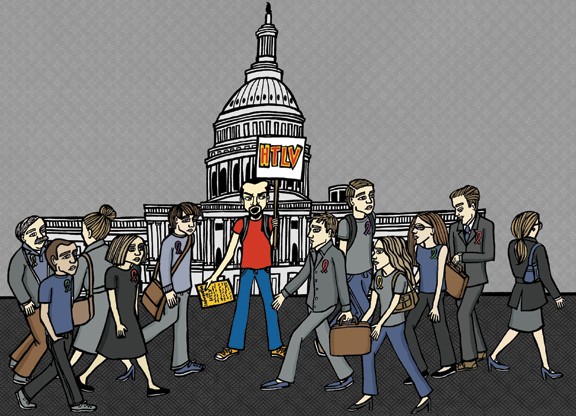In the world of the Internet, “going viral” can be a good thing, referring to something that rises above obscurity in the vast universe of uploaded content on wings of sudden popularity. One man in Kingston, Richard Engnath, is hoping to get that kind of attention, in the universe of public awareness, for a pair of real human viruses called HTLVs. That abbreviation stands for human T-lymphotropic virus, meaning a virus that has affinity for T-lymphocytes (T-cells), which are some of our essential immune cells.
HTLVs have been languishing in relative obscurity, at least in this country, since their discovery in the late 1970s and early 1980s. Two forms had been found: HTLV-1 and HTLV-2, and the first form was associated with leukemia. Then, in 1984, a related virus was discovered: Originally dubbed LAV (lymphadenopathy-associated virus) and also HTLV-3, that virus is now known as human immunodeficiency virus (HIV)—the pathogen responsible for AIDS.
As HIV jumped into the limelight, its cousins were left in the dark. The HTLVs are, like HIV, retroviruses that carry viral RNA into cells and anchor it there permanently. But unlike HIV, which demolishes T-cells from within and sends immune cell numbers crashing, HTLVs don’t kill their host cells. Instead, they produce viral proteins with mixed influences on immune cell machinery, and people who test positive for HTLV-1 or HTLV-2 often are symptom free. But in an estimated 5 percent of cases, serious illness arises.
From Frying Pan to Fire
Engnath would like to have never met the HTLVs. But a suite of tenacious symptoms led him down the path to discovering them, and he has since become a one-man HTLV encyclopedia, and quite possibly the nation’s foremost expert on the subject.
His story begins decades ago, when he emerged relatively unscathed from a risky period of experimenting with injectable drugs—a newly emerging activity in the 1960s. Though he contracted hepatitis C, he’s amazed and grateful he didn’t get anything worse. But about five years ago, his luck ran out.
“I was drug free and smoke free by then,” he explains, “and I hadn’t gotten HIV. I had a friend I had known a long time, and I was thinking it might be nice to have a child with her. I knew she had been in jail, related to a drug habit, but she said she didn’t have HIV. So I took a chance and had unprotected sex with her.”
Within a few weeks, Engnath began having symptoms. “The first thing I got was swollen glands in my throat and neck, like a mild case of mumps, but it spread to other lymph nodes in my underarms, shoulders, and groin, and into other areas, and I got mild otitis, earache.” With those and other problems, Engnath wondered if he’d gotten HIV after all. But his HIV tests kept coming back negative while symptoms kept progressing. An infectious disease specialist told him it was just his imagination.
But Engnath kept looking for answers. “Four months into this, I was on the phone with the Albany Medical Center, and someone at the HIV center said it could be HTLV-1 or HTLV-2. I had never heard of them. I got the medical librarians to download scores of papers about these viruses for me. [Engnath doesn’t have a computer.] There is a lot of research information out there, and some of it said that seroconversion time, when the viruses can be detected in blood, can take up to two years.”
The HTLV Info Void
Over the next several months Engnath visited doctors to get tested periodically, and found that each time he needed to explain what HTLVs were and that tests did actually exist. “I got a local doctor to test for HTLVs four months into my illness, but it came back negative. At seven months I went to an infectious disease doctor in Poughkeepsie, but he wasn’t willing to order the HTLV test again since it had already been negative. At eleven months I went back to the office of the doctor where I first was tested, but he had left the practice and the remaining staff knew little about it and wouldn’t test me. They told me they didn’t want me to come back anymore.”
Finally he convinced an infectious disease doctor in Monticello to test him again for HTLVs, and in January 2006 it came back positive. A more advanced test, through a doctor in Albany, came back positive, for HTLV-2.












